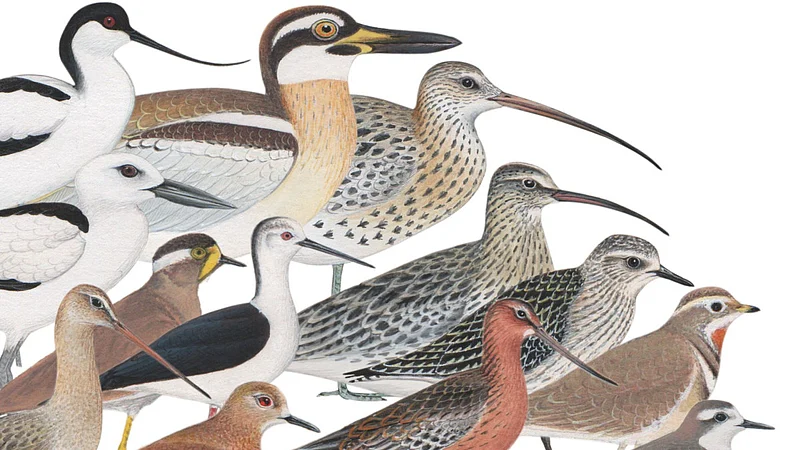Waders of the Indian Subcontinent
By Harkirat Singh Sangha
By Ananda Banerjee
The migration of birds symbolises a fight for life; it is all about undertaking extraordinary journeys. Their flight from one end of the earth to the other, and back again — traversing hemispheres between their breeding and wintering grounds — is awe-inspiring and, sometimes, unbelievable. It is the story of a promise to return, flying thousands of miles beset with dangers. Waders or Shorebirds are among the elite when it comes to long-distance migration, performing some of the longest recorded solo flights. For incredible migrants like the Bar-tailed Godwits, 7,000-plus miles non-stop is a regular affair. Species of Godwits, Sandpipers, Snipes, Stints and Plovers are some of the avian kingdom’s most accomplished fliers visiting us every year. The diversity of waders is stunning; numbering hundreds of thousands, they winter (arriving in autumn) on our coastal beaches, mudflats and shallow inland lakes, before departing in spring for distant breeding grounds in Kazakhstan, Mongolia, Tibet and Siberia (Russia).
Harkirat Singh Sangha’s ‘Waders of the Indian Subcontinent’ is a celebration of these incredible migrants and covers the waders or shorebirds of India, Pakistan, Nepal, Bhutan, Bangladesh, Sri Lanka and the Maldives. The book covers all 83 wader species, in great detail, recorded in India and neighbouring countries, including residents, migrants and a few vagrants.
Sangha gets into detail in bringing us the most comprehensive account to date on this complex group of birds where plumage changes with the season (breeding or non-breeding) and age (juvenile, adult, adult-breeding). Often referred to as dull grey or brown waders, they display a variety of molts, beaks, legs, tails and rump. The author draws from his vast field experiences in describing key identification features, status, range, habitat and voice with distribution maps for all species. The variation in plumage can be confusing to the observer, even to the best of ornithologists in the field. Sangha endeavours to elucidate the issue, but a separate well-designed section could have been a better way to illustrate it for new birders.
The book is not just about identifying waders, but also knowing about their migration routes, known as ‘flyways.’ Sangha writes that “each wader species migrates in a different way and uses a different set of breeding, migration, staging and wintering sites. Hence, a single flyway is composed of many overlapping migration systems of individual wader populations and species, each of which has different habitat preferences and migration strategies.” There are five flyways in Europe and Asia and three in the Americas.
Along with describing migration routes and diverse wader habitats, the book also highlights several threats to wader populations in the Anthropocene. Climate change and human activities are altering much of traditional wader habitats leading to massive population declines. Today, the greatest threat to waders in the Indian subcontinent is habitat loss and degradation. Most wetlands and lakes in the country have either shrunk or obliterated due to encroachment. “If hunting of the waders is stopped most species will probably recover as long as the population has not been reduced below a certain threshold. Polluted rivers and wetlands can be cleaned up allowing the re-establishment of biota. However, many threats are irreversible: for example, once an intertidal flat, the “no-man’s land” between the sea and the shore, has been reclaimed or a wetland drained, it is usually gone forever,” writes Sangha.
Population decline in species like Ruff, Eastern Curlew, Spoon-billed Sandpiper, Asian Dowitcher and Black-tailed Godwit are of great concern to ornithologists and wildlife conservationists. The decline of both migratory and resident wader species has been noticed at many places in the subcontinent. For example, at Point Calimere (Tamil Nadu), the decline is very conspicuous not only to ornithologists but also to the average nature enthusiast. The disappearance of the “clouds” of waders is a visible indicator of the decline. In the 1980s, over 5,00,000 waders wintered at Point Calimere, but were down to 1,00,000 by 2008, as per records maintained by the Bombay Natural History Society. The ringing and census data from Point Calimere indicate that there has been a decline of 70% in certain species of waders since the 1980s. Observations from other notable important bird habitats in the country also clearly indicate an overall population decline.
Conceived back in 2004, the book was worth the wait for Sangha is a specialist with an eye for detail. This is a mighty addition to the rich ornithology of mega-diverse India.
The Call Of The Sarus Crane
By Seema Mullick & Anavi Mullick
India has a resident crane. It’s called the Sarus. This delightful children’s book follows a pair of Sarus Cranes through their journeys of courtship, nesting and parenthood in Dhanauri Kalan, a wetland in Uttar Pradesh, not very far from the national capital. The Sarus, also the world’s tallest flying bird, has brought together three generations; a grandfather, his daughter and his granddaughter in this creative journey. With stunning photographs and engaging verse, the book will help children connect to their immediate natural surroundings.
A sampler:
“A pair of cranes separate from the rest,
searches for a place to build a nest.
A place that is not too dry nor too wet,
shallow water is their best bet.
A loud call to tell the other pairs,
that now this place is theirs.
Together for life, the Sarus pair,
A bond strong they share.”


























